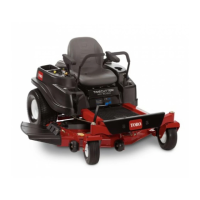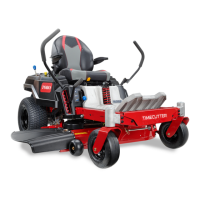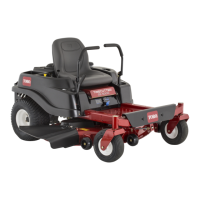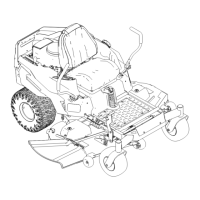g333873
Figure 31
1. Bypass-lever locations
3. Lever position for pushing
the machine
2. Lever position for
operating the machine
5. T urn the ignition key to the R UN position and
disengage the parking brake by moving 1
motion-control lever out of the P ARK position.
Note: Do not start the machine.
6. Move the machine as required.
Important: Always push the machine by
hand. Do not tow the machine, because
towing may damage it.
7. Move the motion-control levers outward to the
P ARK position.
8. T urn the key to the O FF position and remove it to
avoid draining the battery charge.
9. Move both bypass levers rearward and down
through the slotted hole to lock them in place.
T ransporting the Machine
Use a heavy-duty trailer or truck to transport the
machine. Use a full-width ramp. Ensure that the trailer
or truck has all the necessary brakes, lighting, and
marking as required by law . Please carefully read all
the safety instructions. Knowing this information could
help you or bystanders avoid injury . Refer to your
local ordinances for trailer and tie-down requirements.
W ARNING
Driving on the street or roadway without
turn signals, lights, reective markings, or a
slow-moving-vehicle emblem is dangerous
and can lead to accidents, causing personal
injury .
Do not drive the machine on a public street
or roadway .
Selecting a T railer
W ARNING
Loading a machine onto a trailer or truck
increases the possibility of tip-over and could
cause serious injury or death ( Figure 32 ).
• Use only a full-width ramp; do not use
individual ramps for each side of the
machine.
• Do not exceed a 15-degree angle between
the ramp and the ground or between the
ramp and the trailer or truck.
• Ensure that the length of the ramp is at
least 4 times as long as the height of the
trailer or truck bed to the ground. This
ensures that the ramp angle does not
exceed 15 degrees on at ground.
28

